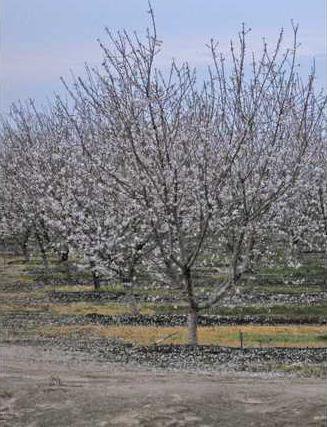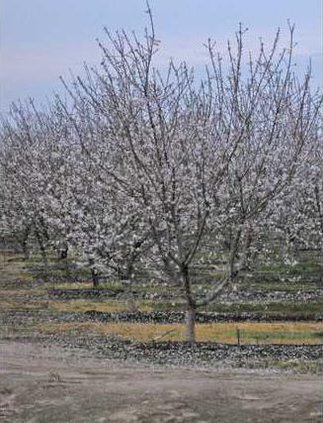In a nut shell — Almond facts
• Almonds were California’s top agricultural export in 2008.
• The pollination of almonds in California is the largest annual managed pollination event in the world.
• California produces the largest supply of almonds in the world and the top growing regions in the state are in the Central Valley.
• The almond shell has multiple uses other than protecting the nut. It’s used as bedding in dairies, processed into fire logs, and used as fiber supplements for animal feeds.
• Almonds were California’s top agricultural export in 2008.
• The pollination of almonds in California is the largest annual managed pollination event in the world.
• California produces the largest supply of almonds in the world and the top growing regions in the state are in the Central Valley.
• The almond shell has multiple uses other than protecting the nut. It’s used as bedding in dairies, processed into fire logs, and used as fiber supplements for animal feeds.
Blooming almond blossoms are one of the signs that sunny weather is on the horizon, but lately with the heavy rains sending the blossoms cascading down to the ground, it’s looking more like a winter wonderland than a bellwether of spring.
The series of storms have certainly given the area a good soaking, but for almond growers, it’s also brought some concerns about the health of their crop.
The blossoms have a window of time from when they first appear, to when they need to be pollinated. They’ll stay viable a little bit longer in colder weather, however, bees don’t really like to leave their hives when the temperatures are in the low 50s and below, and the recent rains have kept them inside their shelters.
Add to that, the supplies of bees are generally tight right now because of colony collapse disorder — an unknown entity or condition that has been killing honey bees at an alarming rate over the last few years.
Growers are also concerned that all the wet weather will leave the trees vulnerable to fungicides, which can ruin a crop.
“Growers have to be at the top of their game right now to stay atop all these issues,” said Bob Curtis, associate director of agricultural affairs with the Almond Board of California.
Despite the difficulties that growers are facing, Curtis said the almond board still expects a “good to excellent” crop in 2010.
The typical time for pollination usually starts in mid February and extends through mid March. Curtis said the front end bloom, which produces the highest nut growth went quite well and that it is the latter bloom that is of concern.
“We’re cautiously optimistic that the latter bloom will produce,” Curtis said. “We just need everything to get in sync. It likely won’t be a record crop, but we will have a better idea when the subjective forecast is done in May.”
What growers really need right now, Curtis says, is a few balmy, dry days that would let the trees dry out and give the bees a chance to do their jobs.
“Bees are opportunistic creatures and even if they’re given just a few hours to get out there, they’ll get down to work,” Curtis said.
To contact Sabra Stafford, e-mail sstafford@turlockjournal.com or call 634-9141 ext. 2002.
The series of storms have certainly given the area a good soaking, but for almond growers, it’s also brought some concerns about the health of their crop.
The blossoms have a window of time from when they first appear, to when they need to be pollinated. They’ll stay viable a little bit longer in colder weather, however, bees don’t really like to leave their hives when the temperatures are in the low 50s and below, and the recent rains have kept them inside their shelters.
Add to that, the supplies of bees are generally tight right now because of colony collapse disorder — an unknown entity or condition that has been killing honey bees at an alarming rate over the last few years.
Growers are also concerned that all the wet weather will leave the trees vulnerable to fungicides, which can ruin a crop.
“Growers have to be at the top of their game right now to stay atop all these issues,” said Bob Curtis, associate director of agricultural affairs with the Almond Board of California.
Despite the difficulties that growers are facing, Curtis said the almond board still expects a “good to excellent” crop in 2010.
The typical time for pollination usually starts in mid February and extends through mid March. Curtis said the front end bloom, which produces the highest nut growth went quite well and that it is the latter bloom that is of concern.
“We’re cautiously optimistic that the latter bloom will produce,” Curtis said. “We just need everything to get in sync. It likely won’t be a record crop, but we will have a better idea when the subjective forecast is done in May.”
What growers really need right now, Curtis says, is a few balmy, dry days that would let the trees dry out and give the bees a chance to do their jobs.
“Bees are opportunistic creatures and even if they’re given just a few hours to get out there, they’ll get down to work,” Curtis said.
To contact Sabra Stafford, e-mail sstafford@turlockjournal.com or call 634-9141 ext. 2002.









